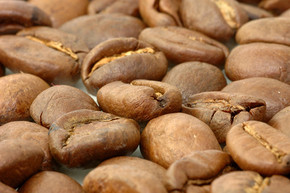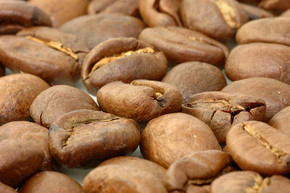Introduction to the hometown of Arabica Coffee and Ethiopia Coffee
Follow the caf é (Wechat official account vdailycom) and found that Beautiful Cafe opened a small shop of its own.
Ethiopia is the hometown of Arabica coffee, and it is in the forests of Kaffa that you can see wild Arabica coffee. In Ethiopian, coffee is called "Bun" or "Buna". Coffee beans (coffeebean) may be translated from "Kaffa Bun". Arabica coffee has long been found in the Harald area, probably from the Kafa forest.

Essel coffee is processed by two processing methods: sun and water washing. The flavor of coffee processed by different processing methods is very different. Generally speaking, the alcohol thickness and soil taste of washed Sidamo, Yirgacheffe and Limmu coffee are slightly lower, and the taste of sun-processed coffee is more wild. But Essex coffee may taste different from batch to batch, which requires more cup tests in order to find really good coffee.
The grade of Ethiopian coffee
● Esser washed coffee Yega Chuefei G1 G2
The highest levels of ● Sidamo (Yirgacheffe, Sidamo) are level 2 and level 3 (G2, G3).
Most of the sun-processed coffee in the eastern part of ● Ethiopia are grade 4 or grade 5 (G4, G5).
In many cases, level 4 coffee is marked as level 5 in order to reduce taxes. The current classification is not uniform and messy, because there are also first-and second-tier (Grand G2) Yirga Cheffe processed by tanning, but the highest level of Harald (Harar) is level four (G4).
The coffee producing areas of Ethiopia are Sidamo, Harald and Sidamo, Harrar and Yirgacheffe. Sidamo and Harrar are provinces and divisions, Sidamo is located in the south of Ethiopia bordering Kenya, and Harrar is bordering Somalia in the east of Ethiopia. Although Yirgacheffe is a community in the Sidamo region, its coffee is considered to be the best in Ethiopia because of soil composition and water content.
In the West, Ethiopian coffee is generally labeled and (Yirgacheffee, Sidamo and Harrar) sold on the market.
In the field of boutique coffee, there are also five other small places of coffee, namely Lim, Gemma, Le Campdi, Becca and Limmu, Djimmah, Lekempti, Bebeka and Wolega. The most common is Essesidamo or Harald coffee (Either Sidamo or Harrar coffee).
Harald Coffee (HarrarCoffee)
Produced from the eastern highlands of Ethiopia, the bean shape is medium size, green and yellow, medium acidity, full alcohol thickness, with a typical mocha flavor (mochaflavor). It is one of the most famous coffee in the world.
Wollega (Nekempte) Coffee
From western Ethiopia, the bean shape is medium to large and is famous for its fruity flavor. The color is green and brown (greenish,brownish color), and the acidity and alcohol thickness are good. Can be made to match, can also be individual products.
Lim coffee (Limu Coffee)
Famous for its aroma and wine flavor (spicy and Winnie flavor), it is very popular in Europe and America. The acidity and alcohol thickness are good, and the water-washed lim coffee is also the favorite of fine coffee. The bean shape is medium, greenish blue, mostly round.
Sidamo Coffee (SidamaCoffee)
Medium bean shape, green gray, Hidamo washed coffee is characterized by balanced taste and flavor, known as sweet coffee (sweet coffee), fine acidity, good alcohol thickness, produced from southern Ethiopia, can be matched with boutique products.
Yega Chevy Coffee (YirgacheffeCoffee)
It has a strong floral flavor. Water washing is one of the best high-estate coffee in the world, with soft acidity and rich alcohol thickness. Top and Bebeka coffee, with low acidity but high alcohol thickness, are indispensable members of the blended coffee.
Important Notice :
前街咖啡 FrontStreet Coffee has moved to new addredd:
FrontStreet Coffee Address: 315,Donghua East Road,GuangZhou
Tel:020 38364473
- Prev

What is 100% Arabica Coffee?
Following caffeine comments (Wechat official account vdailycom) found that when we drink coffee at a beautiful cafe, we seldom care about or don't know the difference between coffee and beans, let alone the huge difference in flavor and taste when we drink coffee because of the refreshing demand for caffeine. Arabica is heard only in advertisements.
- Next

Description of the shape, flavor and taste characteristics of Yunnan Arabica coffee bean varieties
Follow the caf é (Wechat official account vdailycom) found that the Beautiful Cafe opened a small shop of its own Arabica Coffee (Arabica), also known as small grain coffee, small fruit coffee, one of the most important coffee tree species in the world, its excellent flavor and aroma make it the only one of these native species
Related
- Detailed explanation of Jadeite planting Land in Panamanian Jadeite Manor introduction to the grading system of Jadeite competitive bidding, Red bid, Green bid and Rose Summer
- Story of Coffee planting in Brenka region of Costa Rica Stonehenge Manor anaerobic heavy honey treatment of flavor mouth
- What's on the barrel of Blue Mountain Coffee beans?
- Can American coffee also pull flowers? How to use hot American style to pull out a good-looking pattern?
- Can you make a cold extract with coffee beans? What is the right proportion for cold-extracted coffee formula?
- Indonesian PWN Gold Mandrine Coffee Origin Features Flavor How to Chong? Mandolin coffee is American.
- A brief introduction to the flavor characteristics of Brazilian yellow bourbon coffee beans
- What is the effect of different water quality on the flavor of cold-extracted coffee? What kind of water is best for brewing coffee?
- Why do you think of Rose Summer whenever you mention Panamanian coffee?
- Introduction to the characteristics of authentic blue mountain coffee bean producing areas? What is the CIB Coffee Authority in Jamaica?

